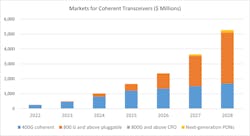Coherence Reborn: Emerging Markets for Coherent Transmission
Coherent transmission was birthed in the 1980s and is now being reborn in the 2020s. Coherent technology began to decline in importance as optical amplification and WDM took over, but interest revived as mobile data traffic boomed, putting pressure on backbone facilities just as EDFA and WDM technology stopped yielding massive capacity gains.
According to CIR’s latest study of next-generation transceivers, coherent communication is currently poised to take on new roles. Coherent transceivers transport more data over a single fiber for greater distances using higher-order modulation techniques, resulting in better spectral efficiency and lower power consumption. Coherent techniques include dual-polarization quadrature phase-shift keying (DP-QPSK) and QAM-16. There are also tunable transceivers that are considered part of the coherent “zoo.”
Coherent in the data center
Right now coherent technology is becoming a much proposed option for data center interconnection (DCI) up to 120 km. The OIF is working to define 800-ZR to address this need, and the 800-ZR spec includes a tunable laser for amplified DWDM links. By contrast, 800G-LR provides for an unamplified single-wavelength coherent transmission up to 2-10 km for campus applications.
Then there is also XR optics, a new pluggable coherent technology that moves coherent beyond point-to-point applications. It was originally developed by Infinera but has now been disseminated through the Open XR Forum, an organization that includes AT&T, BT, Juniper, Sumitomo Electric, Telefónica, Verizon, Windstream, and other powerful players. It has been suggested that XR has a role to play in hyperscale data centers as well as other network locations.
Such specifications apply to general-purpose data centers whether they are hyperscale data centers owned and operated by the great cloud providers, such as Meta, Microsoft, or Apple, or more humble enterprise data centers that belong to conventional industrial, financial, or retail outlets. But coherent optics will also find a market in the edge data centers that CIR expects will be deployed to support the new breed of latency-sensitive traffic generated from AI, machine learning, Internet-of-Things, and augmented reality platforms.
What this edge application will be looking for is a combination of high data rates to help conquer the latency problem – at least partially – and relatively short reach. So, an opportunity for new kinds of coherent transceivers perhaps?
Coherent, PONs, and mobile infrastructure
Coherent may also play a role in 5G/6G wireless infrastructure. While 5G wireless itself is not operating in the hundreds of gigabits, some sources are talking about 6G rates up to 1 Tbps. This sort of data rate will put incredible pressure on the mobile infrastructure, which will no doubt move to 400G and 800G transmission – and probably terabit per second in due course.
Even coherent PONs are now being considered. Coherent PONs will bring data rates up to 100G using EDFAs and bringing PONs closer to how we do conventional optical networks. One version of the coherent PON is a low-complexity coherent PON based on heterodyne/intradyne detection and couplers. Another path to future coherent PONs is a coherent TDM-PON with a wavelength-stable burst-mode transmitter required to minimize detector bandwidths.
Future directions and R&D
To those of us who recall when coherent was for long-haul and regional networks, the idea of coherent PON seems more than a bit futuristic. Yet inevitably as high-volume production of coherent transceivers increases, their price will become competitive with non-coherent (direct detect) alternatives and coherent will then find new roles in more cost-sensitive applications.
We expect that this new economics for coherent will help spur R&D efforts in the coherent transceiver space. One trend that is already real is having silicon photonics deployed to fit coherent technology into transceivers. And in another part of the world of photonic integration – co-packaged optics -- there are already hints in the literature that some coherent version of co-packaged optics will emerge.
Lawrence Gasman is president of CIR, Inc.

